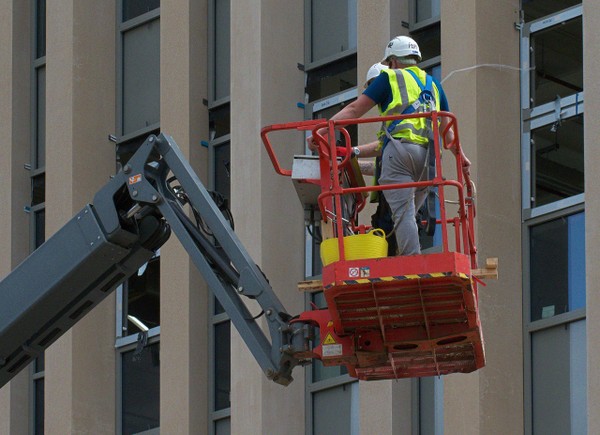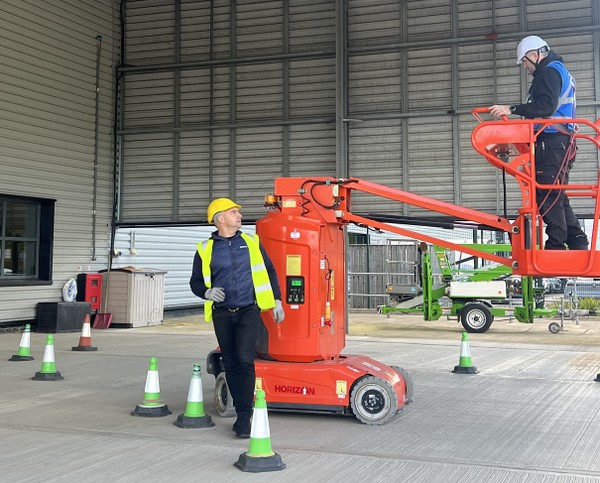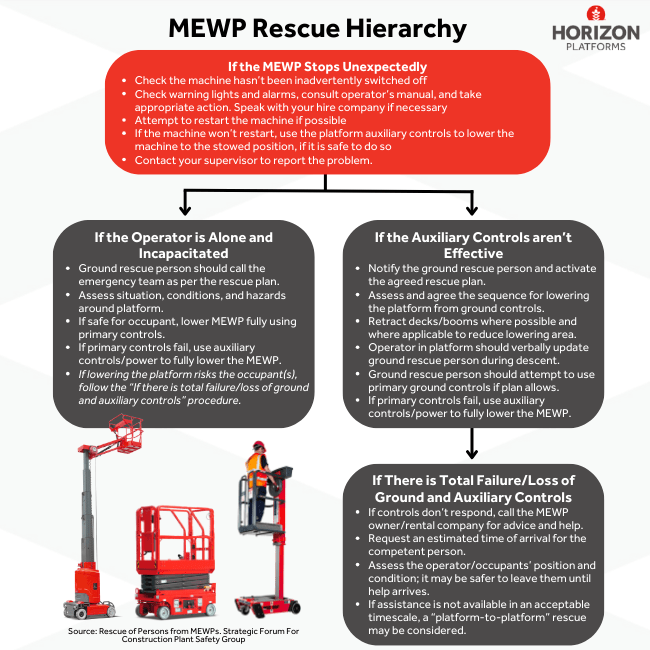Mobile Elevating Work Platforms (MEWPs), also known as access platforms, are vital for safe work at height, but what happens if the platform fails, or other factors leave people stranded at height?
Even with well-maintained machines and experienced MEWP operators, there’s always a small chance of machine faults, operator errors or medical emergencies causing someone to be stuck at height on a MEWP.
What do you do if this happens and are you properly prepared? Not to worry, we’ve consulted IPAF guidance and our IPAF instructors to walk you through the key points for MEWP Rescue Plans, and what managers and operators need to know.
What is a MEWP Rescue Plan?
A MEWP rescue plan is a documented procedure that explains how people will be rescued if a MEWP becomes stuck at height due to breakdown, power failure, operator incapacity, or other causes.
Note: A MEWP Rescue Plan could also be known as a Powered Access Rescue Plan or Access Platform Rescue Plan. It depends on the terminology you use at your work. For this article we’ll stick with MEWP Rescue Plan.
Why is a MEWP Rescue Plan Important?
If you own or hire access platforms, they can stop working for several reasons. Even with well maintained and compliant machines, faults, work environments or operator error can result in someone being stuck at height on a MEWP. Ill health or someone panicking can leave an operator incapacitated and stuck at height. Therefore, having a clear, documented rescue plan for every site using MEWPs, that is effectively communicated to the right people, saves valuable time, reduces risk, and protects lives.
The Legal Framework
Luckily, here in the UK, we have some of the best Health and Safety legislation in the world. Meaning there are frameworks and references to support the creation of safe systems of work for all work activities. The following reference the requirement to provide a means of safe rescue:
- Work at Height Regulations 2005 – Regulation 4(2)
- Lifting Operations and Lifting Equipment Regulations 1998 – Regulation 5(1)(d)
- Management of Health and Safety at Work Regulations 1999 – Regulation 3
- CDM 2015 – Regulation 30 on Emergency Procedures
- The Health and Safety at Work etc Act 1974 – Sections 2 & 3 also set out general duties that require this.
Planning a MEWP Rescue
Planning for rescue from a MEWP requires a clear and well-communicated emergency plan as part of a safe system of work. To try cover possible eventualities, stakeholders, such as health and safety professionals, site leads, and MEWP operators must identify tasks, hazards, risks, and control measures. But, most of all, people should know what they need to do in the event of a MEWP rescue. For example, who is the designated grounds person and who’s in the emergency team.
The plan should cover:
- Roles and responsibilities
- Methods of rescue
- Any equipment required
- Training of competent personnel
- Communication. Not only for sharing the rescue plan but for confirming the line of communication in the event of carrying out a MEWP rescue.
- When, how and who should liaise with the emergency services
- Is the provision of a personnel emergency pack necessary for relieving any potential effects of cold, hunger or thirst.
All arrangements must be recorded in a method statement, shared with those involved, and regularly reviewed with refresher training.
Rescue operations should designate a nominated ground rescue person who is competent with MEWP ground controls and identified to the operator before use. Communication between operator, supervisor, and ground rescue personnel is vital. If the MEWP cannot be lowered, alternatives such as “platform-to- platform” transfer may be considered. Emergency services should not be relied upon as the primary rescue method, though they must be contacted for medical assistance or extreme circumstances.
If you have any queries or need assistance, you can speak with Horizon Platforms or read guidance from IPAF and HSE.
Preventing a MEWP Rescue
Ideally you want to avoid a rescue situation altogether. Therefore, it is important to be proactive in the following 4 areas:
- Risk Assessment and Planning
- Competent Operators and Personnel
- Equipment Maintenance and Inspections
- Safe Operating Practices and Supervision
MEWP Rescue Hierarchy
When needing to reduce someone from a MEWP, it can be a frantic and stressful. So, the image below outlines the MEWP rescue hierarchy and gives a quick refence point for what to do in the following situations:
- The MEWP stops unexpectedly
- The MEWP operator is alone and incapacitated
- The Platform’s auxiliary controls aren’t effective
- There is total failure or loss of ground and auxiliary controls
Need Help with MEWP Rescue Planning?
When you rent access platforms from Horizon Platforms, we immediately become an extension of your team. You get access to access platform hire desk experts, engineers, and technicians, as well as IPAF-qualified instructors; all who have a combined experience of hundreds of years in powered access. So, if you need help with rescue planning, speak with Horizon Platforms.
Reference: Rescue of Persons from MEWPs. Strategic Forum for Construction Plant Safety Group. 2020



